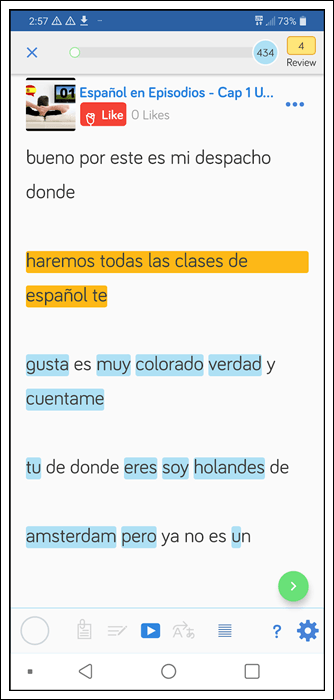Spanish Tongue Twisters: Not for the Faint-Hearted!
If you want to level up your Spanish, you need to practice some of these Spanish tongue twisters!
What Are Tongue Twisters?
Tongue twisters are sets of words or phrases that are grammatically similar and often difficult to pronounce. The words in a tongue twister can be part of the same family of words, like contar, contable y contabilidad or they can be similar words with different meanings, like casado y cazado.
The spanish word for tongue twisters is trabalenguas. This word contains the noun lengua and the verb trabar.
Trabar means to produce mistakes when pronouncing due to the complexity or phonetic similarity of the words. Lengua means tongue and language.

Spanish tongue twisters will not only help you develop a Spanish accent, they can also help improve your pronunciation of difficult vowels. The tongue twisters you’ll learn in this post reflect the culture of Spanish-speaking countries. But remember that you have to recite them quickly, clearly and continuously.
This Word Does Not Exist!
Spanish tongue twisters can use words that do not formally exist, but are formed based on one word that explains its meaning. For example, the mexican twister about an otolaryngologist:
El otorrinolaringólogo de Parangaricutirimícuaro
se quiere desotorrinolangaparangaricutirimicuarizar.
El desotorrinolaringaparangaricutimicuador que logre desotorrinolangaparangaricutirimucuarizarlo,
buen desotorrinolaringaparangaricutimicuador será.
Translation: The otorhinolaryngologist of Parangaricutirimícuaro wants to stop being an otorhinolaryngologist of Parangaricutirimícuaro. The one that achieves un-otorhinolaryngologizing he of Parangaricutirimícuaro, will become a good un-otorhinolaryngologizor of Parangaricutirimícuaro.
In this example, we see that the words are formed from otorrinolaringólogo and parangaricutirimícuaro.
We understand that he wants to stop being a otolaryngologist in Parangaricutirimícuaro thanks to the prefix “des” and suffix “-zar” that are placed at the beginning and the end of the words otorrinolaringólogo and parangaricutirimícuaro. These words do not exists! They were specially formed!
Another peculiarity of tongue twisters that is evident in the examples above is the use of long words that have 20 or more vowels. These make tongue twisters especially difficult as not all words use diacritical marks (a glyph added to a letter that indicates the strongest vowel of the word). Examples: otorrinolaringÓlogo.
A classic tongue twister about a bricked sky also illustrates this! You can understand the meaning of the words thanks to the prefixes and suffixes.
El cielo está enladrillado,
¿quién lo desenladrillará?,
el desenladrillador que lo desenladrille,
buen desenladrillador será.
It means: The sky is bricked, who can unbrick it? The one that unbricks it [desenladrillador can be translated as the one that unbricks it], a good desenladrillador will become.
Can you imagine a bricked sky?

Context Is Everything
Tongue twisters can use one word that has different meanings. They help us understand that in some cases context determines the meaning of the words. For example:
Como poco coco como, poco coco compro.
Here the word como has two meanings: como from the verb comer and como as in “like” or “as”. It means: The less I eat coconut, the less I purchase it. Another example of this:
Si la sierva que te sirve,
no te sirve como sierva,
de qué sirve que te sirvas
de una sierva que no sirve.
In this example, sirve has different meanings. The translation is: If the servant that serves you, does not work as a servant, what is the point of having an incompetent servant?
The phrase “de qué sirve que te sirvas” must not be translated literally.
These words are homophones, that have the same pronunciation and spelling, but different meanings.
How Do You Pronounce These?!

Spanish tongue twisters can help us understand the rules of pronunciation. For example, R and RR have different pronunciation, but R is pronounced as RR when it is at the beginning of the word or after L, N and S as in the words alrededor and enredar. For example:
Por desenredar el enredo que ayer enredé,
hoy enredo el desenredo que desenredé ayer.
In this tongue twister, some Rs are pronounced as RR. The meaning: For untangling the mess I tangled yesterday, today I entangle the mess I untangled yesterday. The word desenredo here means the opposite of enredo. Another tongue twister to practice the R is:
Tres tristes tigres comen trigo en un trigal.
Tanto trigo tragan
que los tres tigres tragones
con el trigo se atragantan.
The meaning: Three sad tigers eat wheat in a wheat field. They swallow so much wheat that the three swallowing tigers choke on the wheat.
Here the word tragones means they eat a lot! We can say that they eat like a horse! This classic tongue twister is well known by all Spanish speaking kids. While the first phrase may be easy, this tongue twister is really difficult to pronounce completely. I am sure that more than one kid had problems with these sad tigers!
Are You From Latin America or Spain?

This tongue twister helps us practice V and B. In Latin America, it may not be considered that hard as the vowels V and B have the same pronunciation, while in Spain it’s more difficult.
Juan tuvo un tubo,
y el tubo que tuvo se le rompió,
y para recuperar el tubo que tuvo,
tuvo que comprar un tubo,
igual al tubo que tuvo.
It means: John had a tube, and the tube he had was broken, and to recover the tube he had, he had to buy a tube, just like the tube he had.
A tongue twister that helps us understand how to pronounce the vowel Ñ, which is uncommon for english speakers, is this one:
En este año el niño Nuñez engañó al ñoño Noreña con la piñata de antaño.
Cuando el ñañigo Coruña encañonando el rebaño, en la cañada, con saña, lo enseñaba a cortar caña.
It means:
In this year the boy Nuñez deceived the spoiled Noreña with the old piñata.
When the ñañigo Coruña, guiding the herd, in the gorge, expertly, he taught him to cut cane.
As mentioned before, tongue twisters can help you understand the culture of a country. This tongue twister is from Cuba. The word ñañigo was a way to address the members of the old Cuban secret society Abakuá, formed only by black Cubans.
Impossible adjectives!

This typical tongue twister about a hen and her chicks has impossible adjectives!
Tengo una gallina
pinta, perlinta, pelizanca, repitiblanca,
con sus pollitos
pintos, perlintos, pelizancos, repitiblancos.
Si la gallina no fuera pinta, perlinta, pelizanca, repitiblanca,
los pollitos no serían pintos, perlintos, pelizancos, repitiblancos.
It means:
I have a hen
Of different colours, perlinta, pelizanca [means with a hairy leg], really white,
With her chicks
Of different colours, perlintos, hairy-legs, really white.
If the hen is not of different colours, perlinta, hairy-leg, really white,
The chicks would not be of different colours, perlintos, hairy-leg, really white.
The word pinta can mean something of different colours, but also scoundrel or unscrupulous. The word pelizanca is formed from two words: the noun pelos and the noun zanca. Zanca is a part of a bird’s leg.
Tongue twisters can also keep secrets! For example, this one:
Dábale arroz a la zorra el abad.
Can you see why it’s special? It is a palindrome! A word or a phrase that can be read the same backward as forward. It means: The abbot gave rice to the fox.
Practicing Consonant Combinations
Tongue twisters can teach us how to pronounce two consonants together, like tl, bl, cl and other combinations. Usually foreigners find it difficult to pronounce these combinations. Here’s a good one:
Pablito clavó un clavito en la calva de un calvito.
En la calva de un calvito, un clavito clavó Pablito.
Pablito clavó un clavito. ¿Que clavito clavó Pablito?
This tongue twister means: Pablito drove a little nail on the bald head of a baldy. In the bald head of a baldy, a little nail was driven by Pablito. Pablito drove a little nail. What little nail did Pablito drive?

When Your Child Wants Bed Time Story…
Tongue twisters can be long and tell a story, like this one about uncle Federico and Paco Peco. The words used are not difficult, but being so similar it is difficult to get them right!
Paco Peco, chico rico, insultaba como un loco a su tío Federico; y éste dijo:
Poco a poco, Paco Peco, poco pico.
Me han dicho que has dicho un dicho que han dicho que he dicho yo, el que lo ha dicho, mintió, y en caso que hubiese dicho ese dicho que tú has dicho que han dicho que he dicho yo, dicho y redicho quedó.
Y estaría muy bien dicho, siempre que yo hubiera dicho ese dicho que tú has dicho que han dicho que he dicho yo.
It means: Paco Peco, a rich boy insulted his Uncle Federico like crazy; And he said: Little by little, Paco Peco, poco pico. I have been told that you have said a saying that they have said that I said, he who said it, has lied, and if he had said that saying that you said that they said that I said, told and retold the saying will stay. And it would be very well said, as long as I had said that saying that you said that they said that I said.
The word poco means less or little and pico from picar means itch! It means that it didn’t itch or bother. The things said didn’t affect Federico.

Disentangle Your Tongue With Spanish Tongue Twisters!
Los trabalenguas se han hecho para destrabar la lengua,
sin trabas ni mengua alguna,
y si alguna mengua traba tu lengua,
con un trabalenguas podrás destrabar tu lengua.
Translation: The tongue twisters have been made to disentangle the tongue, without hindrance or any obstacles, and if any hindrance tangle your tongue, with a tongue twister you can disentangle your tongue.
Indeed, Spanish tongue twisters should untangle your tongue!
Repeat them loudly and clearly!
Learning Spanish on LingQ
Last but not least, you can store your favorite Spanish content all in one place and turn them into interactive lessons to help you study!
Check out LingQ and learn Spanish online using content you love, whether it’s to perfect your tongue twisters or learn how to converse with someone, LingQ’s content is limitless.



